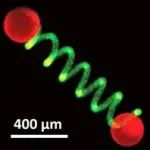Protocells spring into action
2021-06-24
(Press-News.org) A University of Bristol-led team of international scientists with an interest in protoliving technologies, has today published research which paves the way to building new semi-autonomous devices with potential applications in miniaturized soft robotics, microscale sensing and bioengineering.
Micro-actuators are devices that can convert signals and energy into mechanically driven movement in small-scale structures and are important in a wide range of advanced microscale technologies.
Normally, micro-actuators rely on external changes in bulk properties such as pH and temperature to trigger repeatable mechanical transformations. Now, in a new study published today in Nature Chemistry, Professor Stephen Mann from the University of Bristol's School of Chemistry, and the Max Planck Bristol Centre for Minimal Biology together with colleagues Drs Ning Gao, Mei Li, Liangfei Tian, Avinash Patil and Pavan Kumar in the Bristol Centre for Protolife Research demonstrate a new approach that uses internal changes as the trigger for signal-based movement.
In a series of experiments, the researchers successfully embedded tens of thousands of artificial cell-like entities (protocells) within helical filaments of a polysaccharide hydrogel to produce tiny free-standing springs that are chemically powered from within.
The Team first loaded the protocells with urease - an enzyme that generates carbonate ions when supplied with urea - and then captured the artificial cells in a twisting jet of calcium alginate hydrogel using a home-built microfluidic device.
They discovered that the helical filaments start to uncoil in water when the urease is switched on, and that the speed of the lengthwise extension increased as more carbonate ions escaped from the protocells into the surrounding hydrogel.
The coupling of endogenous chemical activity to mechanical movement was associated with the breaking of crosslinks in the hydrogel due to removal of the calcium ions by on-site formation of calcium carbonate particles, which led to the slow release of elastic energy in the spring-like microstructures.
Conversely, reclaiming the calcium ions by dissolving calcium carbonate particles using a second population of acid-producing glucose oxidase-containing protocells placed outside the filaments reversed the uncoiling and re-established the original helical pitch of the free-standing springs.
Based on these observations, the researchers used the helical protocell filaments as a drive shaft for performing protocell-powered mechanical work. For this, they attached a single "giant" protocell at each end of the coiled hydrogel and exploited the tiny dumbbells as free-standing micro-actuators (see image). Urease activity in the two giant protocells was sufficient to cause a lateral extension of the dumbbell. The movement could be curtailed if one of the attached giant protocells contained glucose oxidase, which worked to restore the lost calcium in the hydrogel connector. In this way, a range of different modes of chemical-mechanical transduction could be programmed into the micro-actuators by on-board processing of chemical signals.
Professor Stephen Mann, co-Director of the Max Planck Bristol Centre for Minimal Biology (MPBC) at Bristol, said: "We have a longstanding interest in protoliving technologies. One key challenge is how to interface protocell communities with their environment to produce functional relationships. The new work provides a step in this direction as it illustrates how endogenous chemical processes can be coupled to their energized surroundings to produce a programmable chemo-mechanical micro-system".
Dr Ning Gao, also at the MPBC and School of Chemistry at the University of Bristol added: "We hope that our approach will motivate the fabrication of new types of soft adaptive microstructures that operate via increased levels of autonomy."
INFORMATION:
Paper:
"Chemical-mediated translocation in protocell-based microactuators,' by Gao N, Li M, Tian L, Patil A J, Kumar P B V V S and Mann S in Nature Chemistry.
[Attachments] See images for this press release:

ELSE PRESS RELEASES FROM THIS DATE:
2021-06-24
What The Study Did: Researchers found no association between recent vaccination with the Pfizer-BioNTech BNT162b2 COVID-19 vaccine and risk of facial nerve palsy.
Authors: Asaf Shemer, M.D., of the Shamir Medical Center in Be'er Ya'akov, Israel, is the corresponding author.
To access the embargoed study: Visit our For The Media website at this link https://media.jamanetwork.com/
(doi:10.1001/jamaoto.2021.1259)
Editor's Note: Please see the article for additional information, including other authors, author contributions and affiliations, conflict of interest and financial disclosures, and funding and support.
INFORMATION:
Media ...
2021-06-24
What The Study Did: Researchers estimated the change in life expectancy associated with the COVID-19 pandemic in the United States by race/ethnicity.
Authors: Theresa Andrasfay, Ph.D., of the University of Southern California, Los Angeles, is the corresponding author.
To access the embargoed study: Visit our For The Media website at this link https://media.jamanetwork.com/
(doi:10.1001/jamanetworkopen.2021.14520)
Editor's Note: The article includes funding/support disclosures. Please see the article for additional information, including other authors, author contributions and affiliations, conflict of interest and financial disclosures, and funding and support.
INFORMATION:
Media advisory: The full study is linked to this news release.
Embed ...
2021-06-24
What The Study Did: Patients with COVID-19-related loss of smell were evaluated for one year after the diagnosis.
Authors: Marion Renaud, M.D., of University Hospitals of Strasbourg, France, is the corresponding author.
To access the embargoed study: Visit our For The Media website at this link https://media.jamanetwork.com/
(doi:10.1001/jamanetworkopen.2021.15352)
Editor's Note: The article includes funding/support disclosures. Please see the article for additional information, including other authors, author contributions and affiliations, conflict of interest and financial disclosures, and funding and support.
INFORMATION:
Media advisory: The full study is linked to this news release.
Embed this link to provide ...
2021-06-24
What The Study Did: The incidence of Bell palsy among patients with COVID-19 was compared with individuals vaccinated against the disease.
Authors: Akina Tamaki, M.D., of the University Hospitals Cleveland Medical Center, is the corresponding author.
To access the embargoed study: Visit our For The Media website at this link https://media.jamanetwork.com/
(doi:10.1001/jamaoto.2021.1266)
Editor's Note: The article includes conflicts of interest disclosures. Please see the article for additional information, including other authors, author contributions and affiliations, conflict of interest and financial disclosures, and funding and support.
INFORMATION:
Media advisory: ...
2021-06-24
An updated analysis of American COVID-19 deaths throughout 2020 reveals an even bigger drop in average life expectancy as well as still-substantial disparities by race and ethnicity.
Lead author Theresa Andrasfay, a postdoctoral scholar at the USC Leonard Davis School of Gerontology, and coauthor Noreen Goldman of Princeton University first examined the pandemic's effect on American life expectancy in October 2020. Their initial study, published in Proceedings of the National Academy of Sciences in January 2021, showed the largest single-year decline in life expectancy in at least 40 years and the lowest life expectancy estimated since 2003.
The updated analysis, which included the more than 380,000 US COVID-19 deaths in 2020 and used 2018 life expectancies as a comparison, ...
2021-06-24
When cancers metastasize, cells from the primary tumor break away, travel through the blood or lymph system,
and form new tumors in other body parts. Although metastasis are responsible for more than 90% of all cancer
deaths, limited progress has been made in treating cancers that have spread.
Besides DNA, RNA is the other molecule of life. For several years now, RNA has become just as important as DNA in understanding the book of life. Especially, messenger RNA (mRNA), the basis of the Covid-19 vaccines, has been put in the spotlight. Just as with DNA, in addition to the 4 well known letters (A, U, G, C), there are further letters defining the RNA alphabet or ...
2021-06-24
Discovering and engineering nanobodies with properties suitable for treating human diseases ranging from cancer to COVID-19 is a time-consuming, laborious process.
To that end, University of Michigan researchers found a simple method for identifying nanobodies with drug-like properties suitable for preventing SARS-CoV-2 infections. They demonstrated the approach by generating nanobodies that neutralized the SARS-CoV-2 virus more potently than an antibody isolated from an infected patient and a nanobody isolated from an immunized animal.
Nanobodies are small antibody fragments ...
2021-06-24
Many people don't realize that the trillions of bacteria, viruses, and fungi residing within the gastrointestinal tract--collectively called the gut microbiome-- are connected to overall health, and specifically to cancer.
Manipulating the gut microbiome to produce "beneficial" commensal microbes, which protect the host from pathogens and can boost immune responses, among other things, could potentially help patients respond better to cancer drugs called immune checkpoint inhibitors, a type of immunotherapy.
To that end, researchers at the University of Michigan have developed ...
2021-06-24
Migrating storms and local weather systems known as cyclones and anticyclones were thought to contribute to behaviors and properties of our global weather system. However, the means to probe cyclones and anticyclones were limited. For the first time, researchers demonstrated a new three-dimensional analytical methodology that can quantify the way individual cyclones and anticyclones impact broader weather systems. This study aids longer-term circulation and climate studies, including how storm characteristics may change in the future.
To many people, the term cyclone probably conjures up images of ferocious storm ...
2021-06-24
A study published on 21 May in Child Development shows that the early production of beat gestures with the hands (i.e., gestures normally associated with emphasis that do not represent the semantic content of speech) by infants between 14 and 58 months of age in natural interactions with their carers predicts that in their later development, nearing the age of five, these children obtain better results insofar as their oral narrative skills.
The authors analysed the predictive value of beat gestures, compared with flip gestures of the hands and iconic gestures
However, the study did ...
LAST 30 PRESS RELEASES:
[Press-News.org] Protocells spring into action


